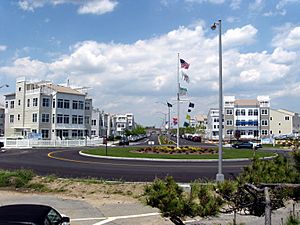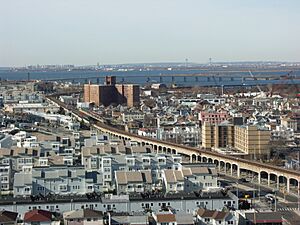Arverne, Queens facts for kids
Quick facts for kids
Arverne
|
|
|---|---|
|
Neighborhood of Queens
|
|

Arverne-by-the-Sea development
|
|
| Country | |
| State | |
| City | |
| County/Borough | |
| Community District | Queens 14 |
| Named for | "R. Vernam", the signature of Remington Vernam |
| Population
(2019)
|
|
| • Total | 22,074 |
| Race and Ethnicity | |
| • Black | 56.8% |
| • Hispanic | 23.3% |
| • White | 11.4% |
| • Asian | 5.3% |
| • other | 3.2% |
| Economics | |
| • Median household income | $46,819 |
| • Per capita income | $24,201 |
| Time zone | UTC−5 (EST) |
| • Summer (DST) | UTC−4 (EDT) |
| ZIP Code |
11692
|
| Area codes | 718, 347, 929, and 917 |
Arverne is a neighborhood in the New York City borough of Queens. It is located on the Rockaway Peninsula. The neighborhood was first developed by Remington Vernam, and its name comes from his signature, "R. Vernam."
Arverne stretches from Beach 54th Street to Beach 79th Street. Its main road is Beach Channel Drive. This road is also known as Rev. Joseph H. May Drive. Arverne is part of Queens Community Board 14. Its ZIP Code is 11692. The New York City Police Department's 100th Precinct looks after the area.
Contents
History of Arverne
How Arverne Started
Remington Vernam first wanted to call the neighborhood Arverne-by-the-Sea. His wife, Florence, had a grand idea for a canal. This canal would run through the neighborhood, like the Amstel canal in Amsterdam, the Netherlands.
This canal plan did not happen. So, the space meant for the canal became a road. This road was called Amstel Boulevard. Most of it later became part of Beach Channel Drive.
Arverne is on the Rockaway Boardwalk. It became famous as a beach town. People could find cheap summer bungalows and hotels there. There were also fun activities and shops along the boardwalk. Many people lived there all year round too.
In 1914, a big storm hit the area. It swept the 1,200-seat Arverne Pier Theater out to sea. In 1922, a fire destroyed a large part of Arverne. About 10,000 people lost their homes. But the neighborhood quickly rebuilt itself. In 1928, there were plans to build 5,000 bungalows in Arverne.
When Arverne Changed
In the 1950s and 1960s, jet travel became popular. People started flying to faraway places for summer vacations. This meant fewer people visited local beaches like Arverne. Many summer bungalows in Arverne became empty.
New York City started "urban renewal" projects in the 1960s. These projects tore down most of the summer resorts. They also removed some homes that had been left empty. In 1964, the city planned to rebuild a large area of Arverne. Old bungalows were torn down to make way for new buildings.
However, the rebuilding project was delayed. There were problems getting money from the government. In 1970, the city said it would build 970 apartments by 1972. By then, only about 100 of the original 900 bungalows were left. The project faced more issues, and many plans were changed or canceled.
New Beginnings for Arverne
In 1984, the city tried again to redevelop Arverne. A large part of Arverne had only one building left: PS 106. In 1988, the city asked private companies to build there. The Dubos Point Wildlife Sanctuary was also created as part of these plans.
By the late 1990s, construction finally began. A new development with 322 two-family houses started. This was the first major building project in the area in 35 years. Other plans were stopped because of money problems in the 1990s.
In the early 2000s, Mayor Michael Bloomberg worked to bring new homes and parks to Arverne. This continued efforts from 1999, when 40 houses were built.
New homes were planned for the "Edgemere Urban Renewal Area." This included 400 houses, a nature preserve, and protected sand dunes. Arverne and other parts of the Rockaways started getting more attention. The area was being reborn as a place to live and visit in the summer.
One of the biggest projects was Arverne by the Sea. It has 2,300 homes and opened in 2006. Even with money problems in 2008, this large development was very successful. Homes sold for high prices. By 2012, Arverne by the Sea was mostly finished. New restaurants and shops, like a Stop and Shop grocery store, opened. This made shopping easier for local people.
In 2018, construction began on another development called The Tides. By 2019, Arverne was changing. New businesses were opening, and the area was becoming more popular.
Education in Arverne
The New York City Department of Education runs the public schools in Arverne. These schools include PS/MS 42 Robert Vernam School and PS 183 Dr. Richard R. Green.
The Queens Public Library has a branch in Arverne. It is located at 312 Beach 54th Street.
Housing in Arverne
- NYCHA (New York City Housing Authority)
- Ocean Bay Houses (Oceanside), used to be Arverne Houses
- Ocean Bay Houses (Bayside), used to be Edgemere Houses
- Carleton Manor
- Mitchell-Lama (affordable housing program)
- Nordeck Apartments (co-operative)
- DHCR (Division of Housing and Community Renewal)
Getting Around Arverne (Transportation)
The New York City Subway has two stations in Arverne: the Beach 67th Street and Beach 60th Street stations. The A train train serves these stations.
Several MTA Bus routes also serve the neighborhood. These include the Q22, Q52 SBS, QM17 buses.
Parks and Nature in Arverne
Kohlreiter Square is a park located on the north side of Rockaway Freeway. It is between Beach 67th and Beach 69th Streets.
Arverne is home to three wildlife sanctuaries. They are all part of the Gateway National Recreation Area.
- Dubos Point Wildlife Sanctuary is near Da Costa Avenue and Beach 65th Street. It faces Jamaica Bay. This sanctuary was named after a scientist named Dr. René Dubos.
- Brant Point Wildlife Sanctuary is west of Beach 72nd Street and north of Hillmeyer Avenue, also on Jamaica Bay.
- Vernam Barbadoes Preserve is on Terrapeninsula. This is a piece of land between two parts of Jamaica Bay. It is west of Beach 75th Street and north of Amstel Boulevard. It was first called the "Terrapeninsula Preserve."
See also
 In Spanish: Arverne (Queens) para niños
In Spanish: Arverne (Queens) para niños


